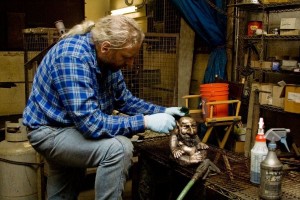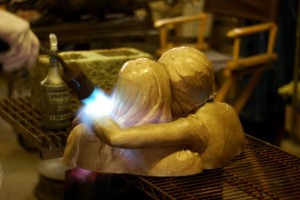Bronze Process
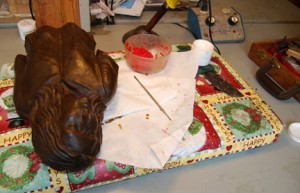 Wax Pattern
Wax Pattern
After the silicone mold is made, hot wax is brushed or poured into the mold to create a hollow replica of the original, with walls around 3/16 of an inch thick. A very small sculpture might be poured solid, but in most cases the quality of a solid casting would suffer while adding unnecessary weight and expense to the piece.
Most wax patterns don’t come out of the mold ready for casting. The next step is wax chasing, which is the process of repairing flaws such as air bubbles or seam lines. At this stage,many artists take the opportunity to inspect the piece and make final adjustments, after which pouring gates are fitted. Pouring gates are a system of channels through which the molten metal passes to ensure a quick, smooth flow without chilling, and to allow gases and air to escape. This is done by melting wax rods, or sprues, to the wax original with a hot metal tool and attaching a wax pouring funnel.
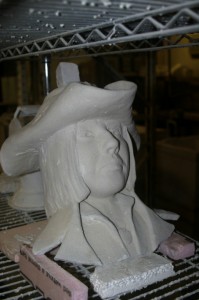 Investment
Investment
Two Ravens Studio uses ceramic shell investment for all of our casting.The wax patterns are dipped into tanks of a silica-based liquid andthen placed into a bed of fine sand to create a reinforced ceramic layer. Each layer dries for several hours or overnight, and the process is repeated 8-10 times to create a thick shell all the way around the wax. When the investment process is finished, the shells are de-waxed in a hot kiln and then prepared for the bronze casting.
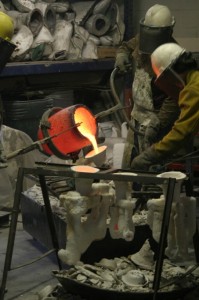 Pouring
Pouring
When the investment process is finished, the shells are de-waxed in a hot kiln and then prepared for the bronze. This is the heart of the casting process! Bronze ingots are melted in a gas-fired furnace and then the molten metal is poured into the shells. As the newborn bronze cools, the shells crack and are destroyed. Later, all remains of ceramic are removed from the bronze with hammers, chisels, and sandblasting.
Metal Finishing
Every bronze piece needs some metal work after pouring. The gates and sprues that we created in wax are now solid metal and need to be removed and recycled.Gas vents are ground off and casting flaws are welded over and repaired. Additionally, most sculptures are cast in multiple pieces and need to be assembled,welded,and tooled with hammers,grinders, sanders, and chisels. Metal-chasing hides the welds and recreates lost texture and details. In addition to assembling cast bronze sculptures, our metal shop is also equipped to fabricate support structures, bases and mountings.
Patina
The finish on a piece is called the patina. The term refers to aged bronze sculptures from ancient times and is often associated with decay or heavy oxidation, but a modern patina can be thought of as any chemical treatment to the surface of the metal that affects its color and shine.
Our most common patinas are called the traditional liver and ferric treatment,referring to the two main chemicals used: liver of sulfur and ferric nitrate. These patinas range from light golden to tan to the deep rich mahogany color known as French brown. We also offer non-traditional patinas which use brushwork, airbrushes, or special effects using white oxides or pigments. Other special finishes use veining or overlapping colors to evoke the look of stone including marble, agate, granites, or sandstone. Most pieces are sealed with hot wax and then protected again with a hard protective cold wax layer and then buffed out to a brilliant shine. The patina can make or break a sculptures, and we always take the time to work with artists to develop the patina that’s right for each piece.

